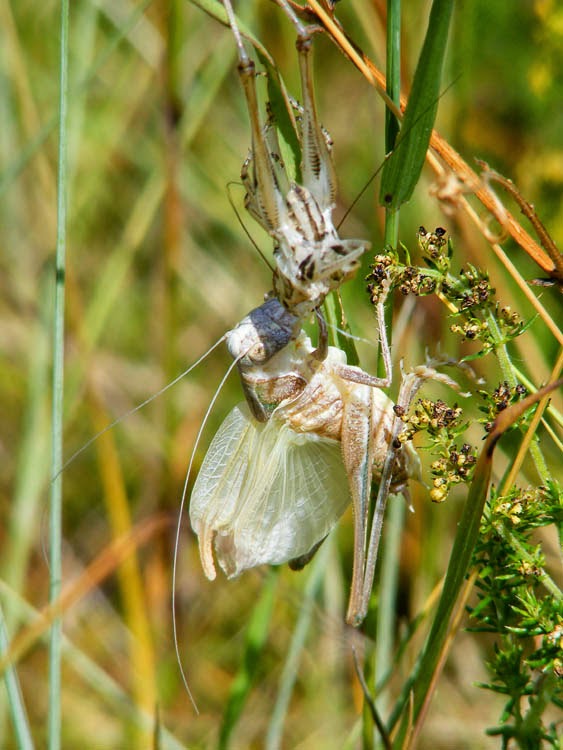A view of les Pelouses de Bertignolles from near the entrance.
On Saturday 21 June Dominique Tessier led a group of botanists from the Association de Botanique et Mycologie de Sainte Maure de Touraine on an outing to the Pelouses de Bertignolles.
Botanists looking at a sedge Carex sp on the edge of one of the shallow pools.
The site is situated on the left bank of the Loire, in that triangle of land known as the Véron, formed by the confluence of the Vienne and the Loire. We met in the car park at Candes Saint Martin, then crossed the bridge over the Vienne and turned left into the site down a dirt track. Sand Broomrape Phelipanche arenaria, rare and specialised in terms of habitat and host (it is parasitic), one of the prettiest of its family.
The flora here is of considerable interest because the substrate is alluvial sand. That meant it was very dry, and Dominique warned everyone that they would get covered in really annoying grass seeds that would get stuck in their socks and boots. I had arrived in shorts and sandals (looking sportive, according to my friend Paul) which Dominique was a bit dubious about, but actually, that turned out to be better than if I had been fully kitted out in hiking boots and socks, as the grass seeds just slid off me. The area is really a low lying sand dune, much of it covered in Grey Hair Grass Corynephorus canescens and Cladonia lichen, which crunches underfoot. In English this type of habitat is called Grey Dunes (Fr. les dunes gris) because of the colour of the vegetation. I've never visited this type of habitat before, and I was fascinated by how different the plant species were and the abundance of interesting insect life.
The gorgeous male chafer beetle Hoplia caerulea, abundant on this site.
Dotted about this dry sandscape were shallow pools with aquatic plants and rabbit warrens which turn out to be very important in the ecological cycle of the site (especially while they wait for a flock of sheep to manage the vegetation).
A grasshopper moulting.
My personal highlights for the day included:- several species of Robberfly Asilidae
- Hoplia caerulea, an irridescent blue chafer beetle which I have never seen live before.
- The chafer beetle Anisoplia cyathigera.
- a Bembix sp sand wasp shoving a grasshopper down its nest hole in the sand.
- an Ammophila sp sand wasp rushing about moving clumps of sand and small bits of wood chip to close its nest hole in the sand.
- Common Forester moth Adscita statices.
- a grasshopper, maybe Euchorthippus declivus, moulting out of an exoskeleton that has become too small as it has grown to adulthood.
- Oak saplings which had signs of animals digging for summer truffles around them.
- a tiny baby Tree Frog (Fr. Rainette).
- Sheep's Bit Jasione montana
- Tasteless Stonecrop Sedum sexangulare
- Reflexed Stonecrop Sedum rupestre (syn. S. reflexum)
- Hoary Allysum Berteroa incana -- this is not native to here, but a common plant, interesting because it was introduced in the 19th century in hay brought by Prussian troops during the Franco-Prussian War.
- Crow Garlic Allium vineale -- this is also a common plant, but I hadn't realised that its French name is Ail des vignes.
- Field Wormwood Artemisia campestris (Fr. Armoise de champêtre)
- Hare's-foot Clover Trifolium arvense
- Yarrow/Sand/Wormwood Broomrape Orobanche purpurea, syn. O. arenaria (Fr. Orobanche de l'armoise), which was parasitising the Field Wormwood.
- Birthwort Aristolochia clematitis (Fr. Aristoloche clematite). For me, Aristolochia is a coastal rainforest plant that is the food plant of birdwing butterflies in Australia, so I was amazed to find a species in this situation.
- Narrow-leafed Lupin Lupinus angustifolius, very rare and protected nationally. One of the flagship species of the site.
- Bastard Lucerne Medicago varia.
An Ammophila sp wasp putting the finishing touches to her nest.







3 comments:
Gorgeous beetle. Hope we'll see
more photos at a later date.
Sheila: I hope to do a follow up with some pics to cheer us up in the winter.
WoW... I have often seen the green jewelled beetles here but to see a blue one is magic! Lucky you to have seen so much!
Post a Comment